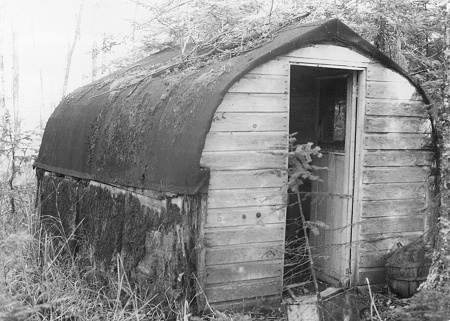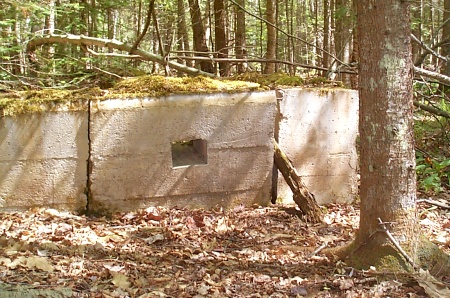| |
Ghosts Of The Apostle Islands
Part Two
Back to Part One
My favorite place
to hunt for ghosts is Sand Island, at the western end of the archipelago.
Sand is one of only two Apostle Islands- the other is Madeline- that was
home to a fully developed community. Settled first in the 1870s, the island
had a population of nearly one hundred at the time of the First World
War. There were two stores, and even a post office. Then, the community
faded as its young people left for the economic opportunity and modern
conveniences of the mainland. The last year-round family moved away in
the autumn of 1944, and since then, the forest has reclaimed the farmers’
fields, and the fishing docks have rotted away.
Still, clues abound for diligent ghost hunters; it’s all a matter of paying attention. Most visitors to the island arrive at the National
Park Service’s East Bay dock, and the majority of these stroll right past
the remains of one of the island’s strangest stories. Tucked in the woods,
mere yards from the dock, there’s a tumbled-down shack made from the hull
of a boat.

Herring
King Cottage, circa 1977
On Thanksgiving Day, 1917, the Herring King was making its last
run of the season. The gas-powered tug was a jack-of-all-trades; its main
job was collecting fish from the island camps, but now and then it would
carry a cargo of lumber or other goods. The Sand Islanders relied on it
to bring groceries and mail from the mainland.
At 2:30 that afternoon, the two-man crew had just cast off from Louis
Moe’s dock near East Bay when a fish keg fell against a fuel line. Gasoline
sprayed onto the hot engine, and in seconds the boat was aflame.
Crewman Clarence Russell jumped into the lifeboat and pushed off. In
his haste, he forgot to grab oars, but the southwest wind quickly carried
him away from the burning tug. Stranded, Captain John Gordon retreated
to the bow, as far as he could get from the flames. By chance, the Duluth-based
steamer Goldish was passing by, close enough to help. Her captain,
S.L. Goldish, was one of the most skilled mariners on Lake Superior, already
renowned for daring rescues. He maneuvered close to the Herring King, then a crewman threw Gordon a life ring. Gordon leaped into the icy
water, swam a few strokes toward safety, then sank from sight. He was
never seen again.
That evening, fishermen towed the charred hulk of the Herring King to shore. One island family soon realized they could put the remains to
use. Turning the hull upside down, they built walls beneath it and turned
the wreck into a cabin. The structure stood for many years, long after
its owners departed the island. Today, though the walls have collapsed,
a sharp-eyed ghost hunter will recognize a boat’s hull in the roofline.
Not every ghost story is sad; Sand Island has its share of laughter and
happy memories, as well. To hear faint echoes of long-ago children’s voices,
make your way just a little bit south of the Herring King cottage. Walk
a few yards west into the woods, and you’ll see a low, masonry foundation:
the remains of the Sand Island school.
From 1910 until the late 1920s, the children of the island’s farmers
and fishermen learned their ABCs in this one-room schoolhouse. When county
authorities decided it was no longer economical to support a teacher on
the island, the school was closed and the settlement’s children forced
to board with families in Bayfield during the school year. The frugal
islanders dismantled the building and salvaged the lumber, leaving the
foundation that you’ll still see today… if you take the time to look.

Sand
Island Schoolhouse: above, circa 1915;
below, the remains today.

While Sand and Basswood Islands have some of the most readily accessible
ghost-hunting spots, there are haunted places on virtually every Apostle
Island. Old boats and net reels molder along the shores, left behind when
the commercial fishery collapsed with the onslaught of the lamprey. The
main trail on Outer Island follows the path of a 1920s logging railroad;
near the island’s northern tip stands a cluster of ramshackle cabins,
left over from a 1950s logging camp.
The narrow sandbar known as Long Island hides a crumbled lighthouse among
its scrubby pines. Here, on a bitter cold morning in 1886, the shocked
keeper of the Old LaPointe light looked out from his tower to see the
wreckage of a schooner lying in the surf. He saw figures clinging to the
masts, but when he hastened to the beach, he realized they were frozen
beyond his help. “I found three bodies,” he wrote in his log, “one in the main and two in the mizzen rigging.”
Today, sport divers often visit the sunken remains of the schooner Lucerne,
but few people ever seek out the brick walls that mark the ruins of the
old lighthouse barely a half-mile away. At Stockton Island, many visitors
enjoy the campgrounds and beaches, but only a few hike to Trout Point
to trace the outlines of an old logging camp on the forest floor. Hunting
Apostle Island ghosts demands a bit of effort, and a smidgen of imagination,
but once you get into the habit, you’ll find plenty of clues as you walk
along the park’s beaches and trails.

Old
LaPointe Lighthouse, Long Island
|
|